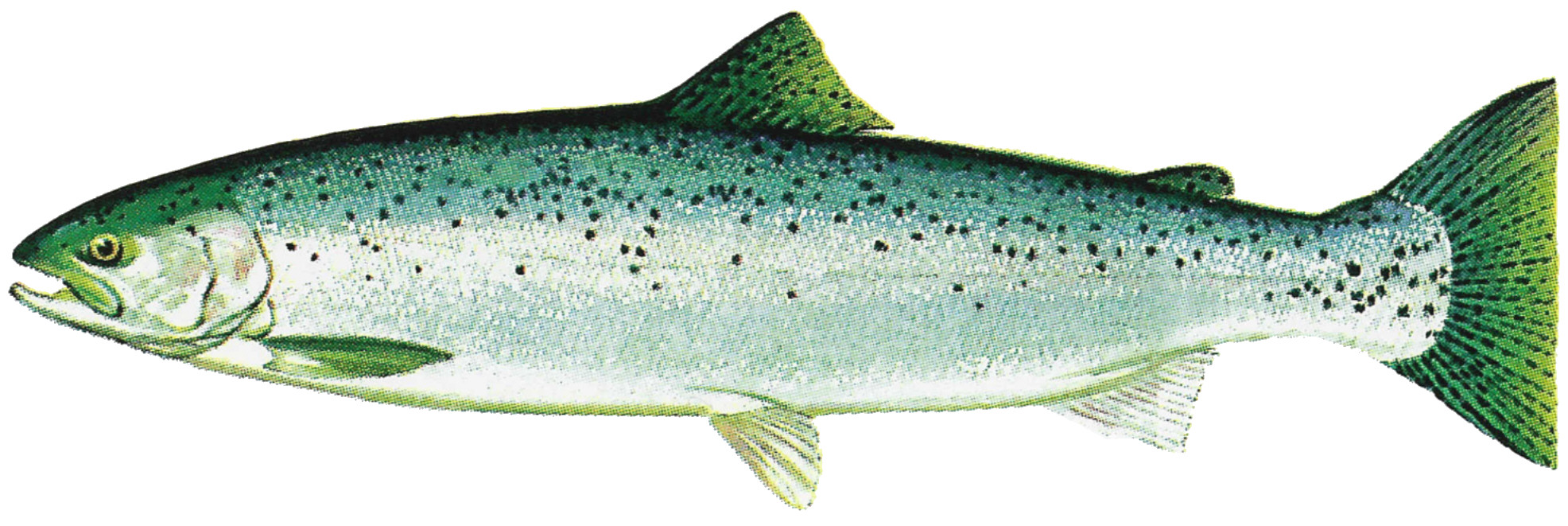|
Cutbow
The cutbow (''Oncorhynchus'' sp. × ''mykiss'') is an hybrid (biology)#Interspecific hybrids, interspecific fertile hybrid between rainbow trout (''Oncorhynchus mykiss'') and cutthroat trout (''Oncorhynchus'' sp.). Based on currently accepted taxonomy, four species-specific hybrid names are recognized for cutbow:Trotter, P., P. Bisson, B. Roper, L. Schultz, C. Ferraris, G.R. Smith and R.F. Stearley. 2018. A special workshop on the taxonomy and evolutionary biology of cutthroat trout. Pages 1–31 in Trotter P, Bisson P, Schultz L, Roper B (editors). Cutthroat Trout: Evolutionary Biology and Taxonomy. Special Publication 36, American Fisheries Society, Bethesda, Maryland. * Coastal cutthroat trout × rainbow trout (''Oncorhynchus clarkii'' × ''mykiss''), or coastal cutbow * Westslope cutthroat trout × rainbow trout (''Oncorhynchus lewisi'' × ''mykiss''), or westlope cutbow * Lahontan cutthroat trout × rainbow trout (''Oncorhynchus henshawii'' × ''mykiss''), or Lahontan cutbow ... [...More Info...] [...Related Items...] OR: [Wikipedia] [Google] [Baidu] |
Rainbow Trout
The rainbow trout (''Oncorhynchus mykiss'') is a species of trout native to cold-water tributary, tributaries of the Pacific Ocean in North America and Asia. The steelhead (sometimes called steelhead trout) is an Fish migration#Classification, anadromous (sea-run) form of the coastal rainbow trout or Columbia River redband trout that usually returns to freshwater to Spawn (biology), spawn after living two to three years in the ocean. Adult freshwater stream rainbow trout average between , while lake-dwelling and anadromous forms may reach . Coloration varies widely based on subspecies, forms, and habitat. Adult fish are distinguished by a broad reddish stripe along the lateral line, from gills to the tail, which is most vivid in breeding males. Wild-caught and Fish hatchery, hatchery-reared forms of the species have been transplanted and introduced for food or sport in at least 45 countries and every continent except Antarctica. Introductions to locations outside their nativ ... [...More Info...] [...Related Items...] OR: [Wikipedia] [Google] [Baidu] |
Cutthroat Trout
The cutthroat trout (''Oncorhynchus clarkii'' clade) is a clade of four fish species of the Family (biology), family Salmonidae native to cold-water Tributary, tributaries of the Pacific Ocean, Rocky Mountains, and Great Basin in North America. These four species are the Coastal cutthroat trout, Coastal (''O. clarkii''), Westslope cutthroat trout, Westslope (''O. lewisi''), Lahontan cutthroat trout, Lahontan (''O. henshawi''), and the Rocky Mountain cutthroat trout, Rocky Mountain (''O. virginalis''). As a member of the genus ''Oncorhynchus'', it is in the Pacific trout group, which includes the widely distributed rainbow trout. Cutthroat trout are popular gamefish, especially among Angling, anglers who enjoy fly fishing. The common name "cutthroat" refers to the distinctive red coloration on the underside of the Mandible, lower jaw. The Specific name (zoology), specific name ''clarkii'' was given to honor explorer William Clark (explorer), William Clark, coleader of the Lewis and ... [...More Info...] [...Related Items...] OR: [Wikipedia] [Google] [Baidu] |
Coastal Cutthroat Trout
The coastal cutthroat trout (''Oncorhynchus clarkii'', sometimes referred as ''Oncorhynchus clarkii clarkii''), also known as the sea-run cutthroat trout, blue-back trout or harvest trout, is one of the four speciesTrotter, Patrick; Bisson, Peter; Roper, Brett; Schultz, Luke; Ferraris, Carl; Smith, Gerald R.; Stearley, Ralph F. (2018), Trotter, Patrick; Bisson, Peter; Shultz, Luke; Roper, Brett (eds.), "A Special Workshop on the Taxonomy and Evolutionary Biology of Cutthroat Trout", ''Cutthroat Trout: Evolutionary Biology and Taxonomy'', American Fisheries Society, , , retrieved 2024-08-12Love Stowell; Metcalf; Markle; Stearly (2018), Trotter; Bisson; Shultz; Roper (eds.), "Species Conceptualization and Delimitation: A Framework for the Taxonomic Revision of Cutthroat Trout", ''Cutthroat Trout: Evolutionary Biology and Taxonomy'', American Fisheries Society, , , retrieved 2024-08-13 of cutthroat trout found in western North America. The coastal cutthroat trout occurs in four dist ... [...More Info...] [...Related Items...] OR: [Wikipedia] [Google] [Baidu] |
Westslope Cutthroat Trout
The Westslope cutthroat trout (''Oncorhynchus lewisi'')Page, Lawrence M.; Bemis, Katherine E.; Espinosa-Pérez, Héctor S.; Findley, Lloyd T.; Gilbert, Carter R.; Hartel, Karsten E.; Lea, Robert N.; Mandrak, Nicholas E.; Neighbors, Margaret A. (2023). ''Common and scientific names of fishes from the United States, Canada, and Mexico''. Special publication (Eighth ed.). Bethesda: American Fisheries Society. . is a freshwater Salmonidae, salmonid in the cutthroat trout complex. The nominate subspecies, also known as the Missouri River cutthroat trout, is ''Oncorhynchus lewisi lewisi''. The Westslope cutthroat trout is the Montana state fish.1-1-507. State fish , Montana Code, accessed 23 April 2009. The Westslope cutthroat trout is a species of concern in Montana and British Columbia ranges and is considered ''threatened'' in its ... [...More Info...] [...Related Items...] OR: [Wikipedia] [Google] [Baidu] |
Hyoid Teeth
The hyoid-bone (lingual-bone or tongue-bone) () is a horseshoe-shaped bone situated in the anterior midline of the neck between the chin and the thyroid-cartilage. At rest, it lies between the base of the mandible and the third cervical vertebra. Unlike other bones, the hyoid is only distantly articulated to other bones by muscles or ligaments. It is the only bone in the human body that is not connected to any other bones. The hyoid is anchored by muscles from the anterior, posterior and inferior directions, and aids in tongue movement and swallowing. The hyoid bone provides attachment to the muscles of the floor of the mouth and the tongue above, the larynx below, and the epiglottis and pharynx behind. Its name is derived . Structure The hyoid bone is classed as an irregular bone and consists of a central part called the body, and two pairs of horns, the greater and lesser horns. Body The body of the hyoid bone is the central part of the hyoid bone. *At the front, t ... [...More Info...] [...Related Items...] OR: [Wikipedia] [Google] [Baidu] |
Dorsal Fin
A dorsal fin is a fin on the back of most marine and freshwater vertebrates. Dorsal fins have evolved independently several times through convergent evolution adapting to marine environments, so the fins are not all homologous. They are found in most fish, in mammals such as whales, and in extinct ancient marine reptiles such as ichthyosaurs. Most have only one dorsal fin, but some have two or three. Wildlife biologists often use the distinctive nicks and wear patterns which develop on the dorsal fins of whales to identify individuals in the field. The bones or cartilages that support the dorsal fin in fish are called pterygiophores. Functions The main purpose of the dorsal fin is usually to stabilize the animal against rolling and to assist in sudden turns. Some species have further adapted their dorsal fins to other uses. The sunfish uses the dorsal fin (and the anal fin Fins are moving appendages protruding from the body of fish that interact with water to ge ... [...More Info...] [...Related Items...] OR: [Wikipedia] [Google] [Baidu] |
Anal Fin
Fins are moving appendages protruding from the body of fish that interact with water to generate thrust and help the fish swim. Apart from the tail or caudal fin, fish fins have no direct connection with the back bone and are supported only by muscles. Fish fins are distinctive anatomical features with varying structures among different clades: in ray-finned fish (Actinopterygii), fins are mainly composed of bony spines or rays covered by a thin stretch of scaleless skin; in lobe-finned fish ( Sarcopterygii) such as coelacanths and lungfish, fins are short rays based around a muscular central bud supported by jointed bones; in cartilaginous fish ( Chondrichthyes) and jawless fish ( Agnatha), fins are fleshy " flippers" supported by a cartilaginous skeleton. Fins at different locations of the fish body serve different purposes, and are divided into two groups: the midsagittal ''unpaired fins'' and the more laterally located ''paired fins''. Unpaired fins are pr ... [...More Info...] [...Related Items...] OR: [Wikipedia] [Google] [Baidu] |
Ichthyologists
Ichthyology is the branch of zoology devoted to the study of fish, including bony fish (Osteichthyes), cartilaginous fish (Chondrichthyes), and jawless fish (Agnatha). According to FishBase, 35,800 species of fish had been described as of March 2025, with approximately 250 new species described each year. Etymology The word is derived from the Ancient Greek words ἰχθύς, ''ikhthus'', meaning "fish"; and λόγος, ''logos'', meaning "study". History The study of fish dates from the Upper Paleolithic Revolution (with the advent of "high culture"). The science of ichthyology was developed in several interconnecting epochs, each with various significant advancements. The study of fish receives its origins from humans' desire to feed, clothe, and equip themselves with useful implements. According to Michael Barton, a prominent ichthyologist and professor at Centre College, "the earliest ichthyologists were hunters and gatherers who had learned how to obtain the most use ... [...More Info...] [...Related Items...] OR: [Wikipedia] [Google] [Baidu] |
North America
North America is a continent in the Northern Hemisphere, Northern and Western Hemisphere, Western hemispheres. North America is bordered to the north by the Arctic Ocean, to the east by the Atlantic Ocean, to the southeast by South America and the Caribbean Sea, and to the south and west by the Pacific Ocean. The region includes Middle America (Americas), Middle America (comprising the Caribbean, Central America, and Mexico) and Northern America. North America covers an area of about , representing approximately 16.5% of Earth's land area and 4.8% of its total surface area. It is the third-largest continent by size after Asia and Africa, and the list of continents and continental subregions by population, fourth-largest continent by population after Asia, Africa, and Europe. , North America's population was estimated as over 592 million people in list of sovereign states and dependent territories in North America, 23 independent states, or about 7.5% of the world's popula ... [...More Info...] [...Related Items...] OR: [Wikipedia] [Google] [Baidu] |
Oncorhynchus
''Oncorhynchus'', from Ancient Greek ὄγκος (''ónkos''), meaning "bend", and ῥύγχος (''rhúnkhos''), meaning "snout", is a genus of ray-finned fish in the subfamily Salmoninae of the family (biology), family Salmonidae, native to coldwater tributaries of the North Pacific basin. The genus contains twelve extant taxon, extant species, namely six species of Pacific salmon and six species of Pacific trout, all of which are fish migration, migratory (either anadromous or potamodromous) mid-trophic level, level predatory fish that display natal homing and semelparity. The name of the genus is derived from Ancient Greek ὄγκος (''ónkos''), meaning "bend", and ῥύγχος (''rhúnkhos''), meaning "snout", in reference to the hooked secondary sexual characteristic — known as the kype — that the males develop on the lower jaw tip during mating season. Range Salmon and trout within ''Oncorhynchus'' are native to the tributaries of the North Pacific Ocean, with th ... [...More Info...] [...Related Items...] OR: [Wikipedia] [Google] [Baidu] |
Columbia River Redband Trout
The Columbia River redband trout, the inland redband trout or the interior redband troutColumbia River Redband Trout - ''Oncorhynchus mykiss gairdneri'' fieldguide.mt.gov (''Oncorhynchus mykiss gairdneri'') is one of three redband trout subspecies of the in the family . It is native in the |
Hybrid (biology)
In biology, a hybrid is the offspring resulting from combining the qualities of two organisms of different varieties, subspecies, species or genera through sexual reproduction. Generally, it means that each cell has genetic material from two different organisms, whereas an individual where some cells are derived from a different organism is called a chimera. Hybrids are not always intermediates between their parents such as in blending inheritance (a now discredited theory in modern genetics by particulate inheritance), but can show hybrid vigor, sometimes growing larger or taller than either parent. The concept of a hybrid is interpreted differently in animal and plant breeding, where there is interest in the individual parentage. In genetics, attention is focused on the numbers of chromosomes. In taxonomy, a key question is how closely related the parent species are. Species are reproductively isolated by strong barriers to hybridization, which include genetic and morph ... [...More Info...] [...Related Items...] OR: [Wikipedia] [Google] [Baidu] |








